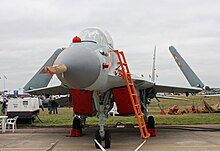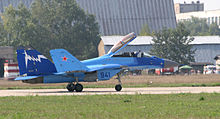From Wikipedia, the free encyclopedia
| MiG-29K | |
|---|---|
| MiG-29K | |
| Role | Carrier-based multirole fighter |
| National origin | Soviet Union / Russia |
| Manufacturer | Mikoyan |
| First flight | 23 July 1988 |
| Status | In production |
| Primary users | Indian Navy Russian Navy |
| Produced | 2005–present[1] |
| Number built | 20 |
| Unit cost | $32 million [2] |
| Developed from | Mikoyan MiG-29M[3] |
Production MIG-29K differ from prototypes by features such as a multi-function radar and several new cockpit displays; the adoption of HOTAS (hands-on-throttle-and-stick) controls; the integration of RVV-AE air-to-air missiles, along with missiles for anti-ship and anti-radar operations; and several ground/strike precision-guided weapons.
The MiG-29K was not ordered into production and only two prototypes were originally built because the Russian Navy preferred the Su-27K in the early 1990s. The Mikoyan Design Bureau did not stop its work on the MiG-29K aircraft despite the lack of financing since 1992. The programme got a boost in the late 1990s to meet an Indian requirement for a ship-borne fighter following the purchase of a former Soviet aircraft carrier. It was first received by the Indian Navy in 2009.
Contents
Development
Origins
The MiG-29K project was initiated in the late 1970s when the Soviet Navy developed a requirement for a supersonic carrier-based fighter. As a first step to meet this requirement, the Mikoyan design bureau designed a "proof of concept" version of the MiG-29 fitted with a stronger undercarriage and a reinforced tail section with an arrestor hook, the MiG-29KVP (Korotkii Vzlet i Posadka, or "short take off and landing").[4] The KVP first flew on 21 August 1982, and was subject to extensive trials which demonstrated it could safely operate from a ski-jump, but ideally a production aircraft needed more power and greater wing area.[5][6] It was decided to base the definitive naval version on the advanced MiG-29M (Product 9.15) that was already under development, further modified with new undercarriage and folding wings of greater area, with the new model designated the MiG-29K (Korabelniy – "ship based") or Project 9-31.[3][7] The MiG-29K differed considerably from the MiG-29 production model, featuring a new multi-function radar, dubbed Zhuk; a cockpit with monochrome display and use of the HOTAS (hands-on-throttle-and-stick) principle; the RVV-AE air-to-air active homing missiles; antiship and antiradar missiles; as well as air-to-ground precision-guided weapons. To protect the engine from FOD, the engine inlets were fitted with retractable grills instead of the LERX louvres used by land-based MiG-29s.[8][9]During its tests aboard the Admiral Kuznetsov aircraft-carrying cruiser, the aircraft had a springboard-assisted takeoff from strips 195 m and 95 m long. According to the results of the tests, the landing accuracy proved to be very high, which made it possible at a later stage to switch over to a three-cable arrester system on the Admiral Gorshkov. The landing accuracy is additionally enhanced through the employment of an autothrottle system. The takeoff characteristics allow for most flights to be possible under tropical conditions at a ship speed of 10 knots.[17][18]
Revival
The MiG-29K program was revived in response to the decision of the Indian Navy to acquire the former Soviet Navy aircraft carrier Admiral Gorshkov in 2004.[19] When Admiral Gorshkov was part of the Soviet fleet, it was a hybrid carrier/cruiser using vertical take-off (V/STOL) aircraft; thus the deck was refurbished with a take-off ramp and arrestor wires for operating MiG-29Ks.[8] The ship's combat group is likely to include 12 MiG-29K fighters. The aircraft has an enlarged and folding wing, an arrestor hook and a corrosion-protected reinforced fuselage.[20]One factor favouring the MiG-29K over the Su-33 in the Indian decision was the larger size of the Su-33, which further limited the number of aircraft on deck.[21][22] Modifications were made to the MiG-29K for Indian requirements, including the Zhuk-ME radar, RD-33MK engine, a combat payload up to 5,500 kg, 13 hardpoints, and updated 4-channel digital fly-by-wire flight control system. It is compatible with the full range of weapons carried by the MiG-29M and MiG-29SMT.[23] The MiG-29KUB made its maiden flight at the Zhukovsky test centre on 22 January 2007.[24]
The problem of lack of aircraft-carrier based AWACS platform may be tackled by further development of dual-seat MiG-29KUB. It is theoretically possible to outfit the MiG-29KUB with powerful radar, and encrypted data links, to permit networking of multiple MiG-29KUB aircraft for AEW coverage. The MiG-29KUB may also be enhanced in areas such as electronic warfare and long-range interdiction.[17][18]
The MiG-29KUB two-seat variant took its first flight on 20 January 2007.[25]
Design
Overview
The MiG-29K was drastically modified from the Mikoyan MiG-29M for naval operations. The airframe and undercarriage were reinforced to withstand the stress experienced upon landing. Folding wings, an arrestor hook, and catapult attachments were added for carrier operations; the aircraft's undercarriage was also widened. The MiG-29K, unlike the early MiG-29, can both conduct aerial refueling and "buddy" refuel other aircraft.[8]The MiG-29K has two widely-spaced RD-33MKs. The early prototypes were fitted with two RD-33K turbofan engines, each with afterburner thrust of 86.3 kN (19,800 lb) and a possible take-off thrust of 92.2 kN (20,723 lbf) for shipborne operations.[26][27] The RD-33MK engine features 7% higher power over the base RD-33, enabled by the usage of improved materials for the turbine blades.[28][29]
Internal fuel was increased from 3,340 kg to 4,560 kg, to give a combat radius of 850 km (531 mi). The range can be increased to 3,000 kilometers with 3 underwing fuel drop tanks. The maximum weight of the aircraft grew from 19.5 to 22.4 t, to allow for increased payloads.[30] The MiG-29KUB two-seat fighter, intended for pilot training, can also conduct combat missions identical to the single-seat fighter.[1]
Cockpit and avionics
The aircraft is equipped with three multifunctional color liquid-crystal displays (seven LCDs on the MiG-29KUB), a four-channel digital fly-by-wire flight control system, passive anti-radar missile homing system, Sigma-95 GPS receiver, TopGun helmet-mounted targeting system and electronic countermeasures (ECM). Additionally, an onboard oxygen generating system eliminates the need for heavy oxygen canisters.[1] The types of combat missions undertaken by the MiG-29K can be increased by adding optronic/infrared imaging reconnaissance pods.[17][18]The Zhuk-ME is a development of the N010 Zhuk radar, introducing functions such as terrain mapping and following. The radar, weighing 220 kilograms (490 lb), features improved signal processing and a detection range of up to 120 km vs a 5 m2 RCS target for the export variant. In the air targeting mode, up to 10 targets can be tracked and 4 targets engaged simultaneously.[31] In air to surface mode the radar can detect a tank from up to 25 kilometres (16 mi) away and a bridge from 120 kilometres (75 mi) away, a naval destroyer could be detected up to 300 kilometres (190 mi) away, while up to two surface targets can be tracked at once. The radar has a scanning area of +/- 85 degrees in azimuth and +56/-40 in elevation.[31]
The Zhuk-AE radar was developed with modular approach, enabling upgrade of existing Zhuk ME radars deployed in MiG-29 platforms into the active electronically scanned array (AESA) Zhuk-AE standard. India is already operating the Bars phased array radar on its Su-30MKI and has specified AESA as a critical element of the MRCA platform.[32] The Mig-29K can be outfitted with an IRST system integrated with both optical and laser systems.[1] It can provide targeting solutions for ground and air targets at up to 15 km, with all-round 360 degree coverage. The IRST can also provide detailed trajectories of missiles at closer ranges.
Weapons and defensive capabilities

A MiG-29K and its armaments at MAKS Airshow.The folded wings maximise the limited space available on an aircraft carrier.
The MiG-29K has a combination of low-observable technology, advanced electronic-warfare capabilities, reduced ballistic vulnerability, and standoff weapons to enhance the fighter's survivability.[23] According to Mikoyan, extensive use of radar-absorbent materials reduce the MiG-29K's radar signature 4–5 times over the basic MiG-29.[23] The RD-33MK turbofan engine was also engineered to reduce infrared and optical visibility.[28][29]
Operational history
India
Further MiG-29K orders by India were frozen after a MiG-29KUB crashed during testing in Russia prior to delivery to India; the Indian Defense Ministry commented that the crash cast a shadow on the credibility of the aircraft.[39] Russia later announced that pilot error had caused the crash, and there was no need to ground the aircraft.[40] In August 2011, MiG's General Director Sergei Korotkov announced that the final 5 out of the 16 aircraft contracted in 2004 would be delivered by the end of the year; and that deliveries of a second batch of 29 MiG-29Ks would begin in 2012.[41] In November 2012, the MiG-29K/KUB completed sea trials for the Indian Navy.[42]
Russia
The Russian Navy has a fleet of approximately 20 Su-33s, which are expected to be life expired by 2015. Production of new Su-33s is possible but not cost-effective for small volumes. The MiG-29K was more convenient, as the Indian Navy had already ordered the aircraft, saving on development and production set-up. India paid $730 million for the development and delivery of 16 units, while 24 for the Russian Navy would cost approximately $1 billion.[43] In September 2011, it was announced that the MiG-29K was to conduct its first at-sea deployment on board Admiral Kuznetsov in the Mediterranean.[44]The Russian Navy ordered 24 MiG-29Ks in late 2009 for the Admiral Kuznetsov.[45] Deliveries of the MiG-29K for the Russian Navy started in 2010.[46][47] MiG and Russia were in final negotiations for an order for more MiG-29K/KUB aircraft in August 2011,[48] with an order for 20 MiG-29K fighter-bombers and four MiG-29KUB operational trainers for operation from Admiral Kuznetsov, replacing the Sukhoi Su-33, being officially announced during February 2012.[49]
Variants
Operators
Main article: List of Mikoyan MiG-29 operators
- Indian Navy – Naval Air Arm has 45 MiG-29K/KUB aircraft on order as of March 2010.[50][51] The naval air arm has 20 aircraft in inventory[52]
- Russian Navy – Russian Naval Aviation is to get 20 MiG-29K and 4 MiG-29KUB delivered between 2013 and 2015.[53]
Accidents
- On 23 June 2011, a MiG-29KUB crashed during testing in Russia, prior to delivery to India, killing its two pilots.[54][55]
Specifications (MiG-29K)
| MiG-29 overview | |
- Crew: One / Two (KUB)
- Length: 17.3 m (57.76 ft)
- Wingspan: 11.99 m (39.34 ft)
- Height: 4.40 m (14.44 ft)
- Wing area: 43 m² (462 ft²)
- Loaded weight: 18,550 kg (40,900 lb)
- Max. takeoff weight: 24,500 kg (54,000 lb)
- Powerplant: 2 × Klimov RD-33MK afterburning turbofans, 9,000 kgf (88.3 kN, 19,800 lbf) each
- Maximum speed: Mach 2+ (2,200 km/h, 1,370 mph) / At low altitude: Mach 1.2 (1,400 km/h, 870 mph)
- Ferry range: 2,100 km(1,240 mi)/ 3,000 km (1,860 mi) with 3 drop tanks
- Service ceiling: 17,500 m (57,400 ft)
- Rate of climb: initial 330 m/s, average 109 m/s 0-6000 m (65,000 ft/min)
- Wing loading: 442 kg/m² (90.5 lb/ft²)
- Thrust/weight: 0.97
- 1 x 30 mm GSh-30-1 cannon with 150 rounds
- 9 hardpoints (5 wet): 8 x under-wing, 1 x centerline for up to 5,500 kg (12,125 lb) of weapons and fuel tanks, including
- Air-to-air missiles
- Air-to-surface missiles
- Anti-radiation missiles
- Anti-ship missiles
- Bombs
- RBK-250
- RBK-500
- RBK-750
- FAB 500-M62 General-purpose bomb,
- FAB-1000, (1,500 kg / 3,300 lb),
- KAB-500KR electro-optical TV-guided fire and forget bomb
- Others
- Flares/Infrared decoys dispenser pod and chaff pod or
- Electronic countermeasures (ECM) pod or
- Targeting pods or
- Refuelling pods or
- Zhuk -ME radar
- Infrared search and track system
- SPO-15 Beryoza RWR (radar warning receiver)
See also
- Related development
- Aircraft of comparable role, configuration and era
- Related lists











No comments:
Post a Comment